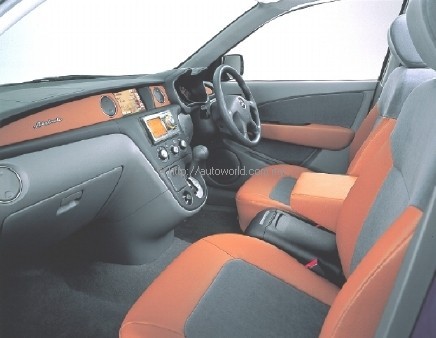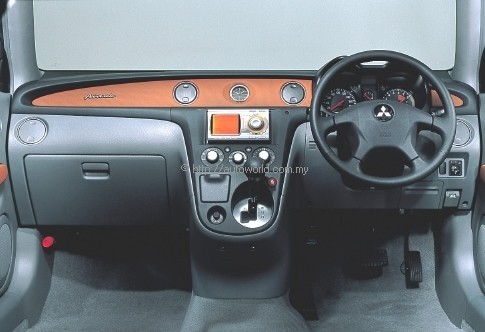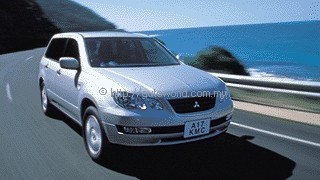Page 2
Trendy interior colour
Inside the cabin, which has a seating space almost 2 metres long, there’s a sporty flavour in the appointments and interior design. You may have noticed in the advertisement that there is an orange shade (terracota orange, it’s called) for the trim and one of the reasons for this colour is to create an ambience that is “emotionally evocative and distinct”. Other trim colours are also offered in Japan but USF feels that this unique colour would appeal to trendy Malaysians. Interestingly, an interior designer in another company has said that orange is going to be one of the popular auto colours of 2002.
The dashboard, though having a futuristic cubist theme, also brings to mind the sportscars of the 1960s with its distinctive T-shaped layout. This mixture, Mitsubishi Motors’ designers hope, will appeal to the younger buyers and also evoke a sense of nostalgia among the more mature drivers.
The instrument panel is sporty in appearance with a twin-dial layout that takes its motif from aircraft instrumentation. At the centre of the dashboard are simple controls with a unique shift lever. Instead of sticking out from the floor or steering column, the lever is situated on the lower section of the dashboard. This frees the space on the floor and between the front seats so occupants can walk to the rear section easily (great for rainy days!).
At this time, it is not known what sort of accessories the Airtrek imported by USF will come with although, being an imported model, it is likely that it will come with some interesting features. An interesting provision is a 100V AC socket which should be useful for those who have electronic devices that aren’t compatible with the traditional 12V cigarette lighter socket.
What is known, however, is that the USF Airtreks will come with sunroofs – the forward one which can tilt and slide open, and another glass panel on the rear section of the roof – as well as a rear spoiler and roof rail.
High safety standards
The body structure uses Mitsubishi RISE (Realized Impact Safety Evolution) construction that combines a high energy-absorbing front section with a rigid cabin cell structure to provide omnidirectional occupant safety in a crash. It meets prevailing crash test requirements, including the European 64 km/h offset frontal impact test. Dual front airbags are standard while ABS with EBD is included in the disc/drum brake system.
A proprietary computerised system links all the factory-fitted electrical devices and systems of the Airtrek and it’s said to be a ‘smart’ wiring system. One of its features is the automatic unlocking of doors after a crash. This feature, common on expensive German models, makes use of the sensor for the airbag system and also unlocks the doors if there is a side impact. The reason for such a feature is to allow the occupants to get out quickly after an accident, or enable rescuers to get them out.
4G63 engine
Various engines are available in Japan but USF has decided to bring in the version with the 2.0-litre 4G63 ECI-Multi engine. This is a SOHC 16-valver which develops 93 kW/126 ps at 5500 rpm and 173 Nm of torque at 4500 rpm. Fuel economy of this engine is claimed to be 11 kms/litre (31 mpg).
“We did consider the 2.4-litre GDI engine but were advised by Mitsubishi’s engineers that the quality of fuel in Malaysia may not be suitable enough for the advanced engine. As we don’t want to inconvenience our customers with unnecessary problems, we decided not to order the Airtrek with the GDI engine,” revealed Ms Wan.
Intelligent autobox
The engine delivers power to all four wheels through an INVECS-II 4-speed automatic transmission, a state-of-the-art unit with the latest developments in Mitsubishi control technology. INVECS-II is claimed to mimic the human decision-making process for slick responses and fast gearchanges. Its Adaptive Shift Control automatically compensates for the effect on shift feel in engine performance or wear in transmission components over times. It can also adapt to different drivers’ styles of driving and provide a customised shift program for each driver.
The transmission has a Sports mode but this isn’t like the ‘sports modes’ found in other cars which refers to an alternate shifting pattern that is more ‘aggressive’. Instead, it is more like the ‘tiptronic’ systems (Mitsubishi Motors calls their system ‘manutronic’) whereby the driver can manually change gears. Sports mode is activated by moving the dash-mounted shifter to the left and then pushing it up to upshift or down to select a lower gear.
Full-time 4WD
The Airtrek is not in the same category as the Honda CR-V or Ford Escape as its drivetrain is a full-time 4WD type. This puts it in the category of the Toyota RAV4 and Land Rover Freelander. Power distribution goes to front and rear wheels all the time and on dry roads, the split is 50:50. As slippage occurs on the front or rear wheels, torque is adjusted by a viscous coupling and apportioned through a centre differential. The latter is an important component to avoid the problem of different rotational speeds between the front and rear axles.
The suspension layout looks like it was adapted from a car with its independent MacPherson struts in front and an independent multi-link arrangement at the rear. This should give the Airtrek a fairly comfortable ride and there is also the promise of good handling stability.
At this time, USF says it will be offering the Airtrek in Peninsula Malaysia for RM145,000, a very attractive price considering that the CR-V and Escape are in the RM140,000 range. However, the Airtrek’s price does not include insurance and roadtax so when you add those in, it will be in the upper RM140,000 bracket – still a good buy for a completely built-up import. Because of USF’s pricing, it is believed that the private importers who were selling their Airtreks at around RM170,000 are now willing to drop their prices to around RM150,000 (so imagine how much their profit margin is!).

























